Explore the latest insights from top science journals in the Muser Press daily roundup (October 29, 2025), featuring impactful research on climate change challenges.
In brief:
Environmental shifts are pushing endangered reptiles to the brink of extinction
New research published in Current Biology originates from an international collaboration with Museums Victoria Research Institute and the Museum für Naturkunde Berlin. The study reveals that the endangered Australian Mountain Dragon (Rankinia diemensis) has been driven into increasingly smaller and more isolated populations over thousands of years as a result of changing climate conditions.
The study combines fossil evidence from natural history museums with genetic data from preserved specimens to uncover how the species has responded to major environmental changes in the past and what this means for its future.
Dr Jane Melville, senior curator of terrestrial vertebrates at Museums Victoria Research Institute, said the research shows the species has been pushed up the mountains by climate change.
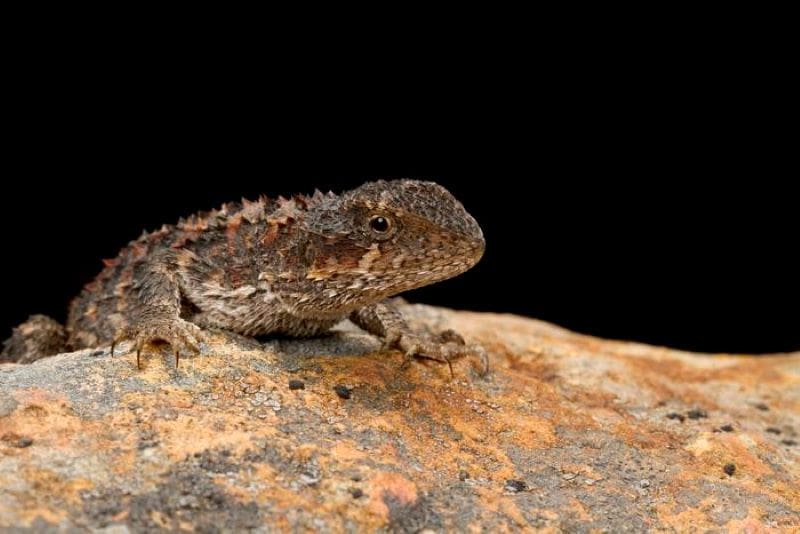
“About 20,000 years ago during the last glacial period, Mountain Dragons occupied a much wider range across southeastern Australia, including regions such as Kangaroo Island and Naracoorte in South Australia,” said Dr Melville. “Today, those populations have vanished. The remaining populations in Victoria, New South Wales and Tasmania have a reduced distribution and are more genetically isolated than in the past, and if global temperatures continue to rise, these lizards will eventually have nowhere left to go.”
By using advanced micro-CT imaging to identify tiny fossil fragments and combining this information with genomic data from modern specimens, the team was able to track long-term shifts in the species’ range and genetic diversity.
The findings suggest that low-altitude populations have already suffered genetic decline, while cooler, high-altitude habitats are becoming less suitable due to global warming. This makes Rankinia diemensis a clear warning sign for other reptiles that share the same ecosystem.
Reptiles are particularly vulnerable to climate change because they cannot actively regulate their body temperature. Similar distribution and genetic patterns have been observed in other species, such as the blotched Blue-Tongue Lizard, Tiliqua nigrolutea, suggesting that multiple reptile species across southeastern Australia may face the same fate.
Natural history museum collections proved essential to this discovery. Fossils, bones, and preserved specimens housed at Museums Victoria and other institutions offer an unparalleled record of Australia’s biodiversity over time, making it possible to link the past, present, and future of threatened species.
Lead author Dr Till Ramm, former PhD student at Museums Victoria Research Institute, said the study underscores the value of the new research field ‘conservation paleobiology’ and the urgent need to update conservation strategies to account for climate-driven habitat loss.
“By learning from the past, we can make better predictions and decisions for the future,” said Dr Ramm. “Our findings show just how fast climate change can disrupt biodiversity and why protecting habitats now is more critical than ever.”
“By studying specimens and fossils preserved in museum collections, we can see how species have responded to past environmental challenges and use those insights to inform future conservation,” said Dr Nurin Veis, Director of Museums Victoria Research Institute. “The past holds critical lessons for protecting the biodiversity we have today.”
Visitors to Melbourne Museum can see 3D models of the Mountain Dragon in the Research Institute Gallery and explore Our Wondrous Planet, Museums Victoria’s newest science and biodiversity gallery, which inspires visitors to care for our planet for generations to come.
Journal Reference:
Ramm, Till et al., ‘Climate change predicts Quaternary extinctions and extant genetic diversity in a threatened Australian lizard’, Current Biology (2025). DOI: 10.1016/j.cub.2025.09.067. Also available on ScienceDirect.
Article Source:
Press Release/Material by Museums Victoria
Cul-de-sac effect: Why Mediterranean regions are becoming more prone to extreme floods in a changing climate
Key Messages
- In May 2023, devastating floods hit Emilia-Romagna, causing deaths, displacement, and estimated damages of €8.5 billion.
- Cul-de-sac effect: The CMCC research team described for the first time how a specific configuration of mountain topography and circulation patterns trapped moisture coming from the Adriatic, while a stationary cyclone fueled prolonged rains that lasted for several days over the same area, leading to extreme flooding.
- From the analysis of the Emilia-Romagna case, the research suggests that the same effect could occur in geographical areas with a similar orographic conformation in the Mediterranean region.
- Extreme events of this magnitude, which have been very rare so far, could become more frequent in a continuously warming Mediterranean climate, as demonstrated by research analysing trends over the past 40 years.
- CMCC researchers have developed cyclone density persistence, a new metric that could prove useful in improving early warning systems.
- From the analysis of past events and in light of the cul-de-sac effect, the study highlights the urgent need for better monitoring, forecasting, and preparedness across Mediterranean regions.
In May 2023, Italy’s Emilia-Romagna region experienced devastating, if not unprecedented, floods that caused widespread damage to infrastructure, homes, businesses, and farmland. Seventeen people lost their lives, and the disaster caused an estimated €8.5 billion in damages. The persistent rainfall and resulting landslides and flooding displaced tens of thousands of residents, leaving a deep mark on the region’s economy and communities.
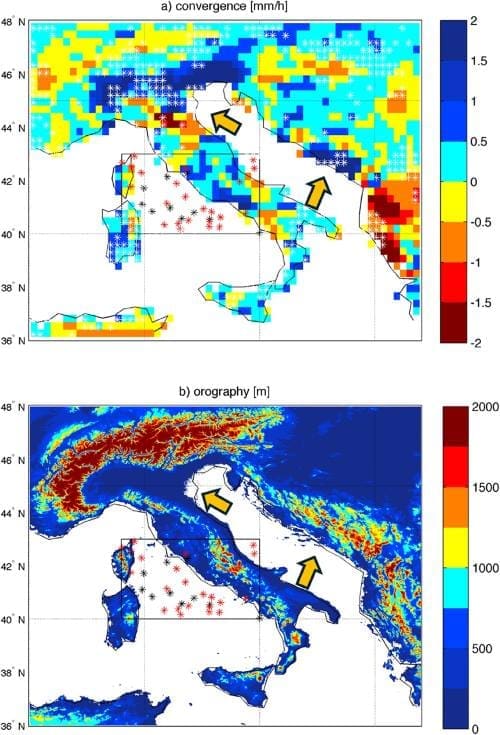
New research from the Euro-Mediterranean Center on Climate Change (CMCC) sheds light on why this extreme event occurred, the role that climate change may have played, and what it could mean for the future of the Mediterranean region and beyond.
The study ‘A cul-de-sac effect makes Emilia-Romagna more prone to floods in a changing climate’, published in Scientific Reports, finds that the extreme flooding was not the result of a single extreme precipitation event, but was fueled by prolonged accumulation of rain over several days.
CMCC scientists describe a “cul-de-sac” effect, where mountains block moisture from the Adriatic Sea, trapping rain over the region and causing extremely rare floods which, statistically, would be expected to happen only once every 500 years.
Researchers identified a stationary cyclone over central Italy as a key driver, channeling humid air from the Adriatic Sea toward the region of Emilia-Romagna. A similar configuration is also believed to have led to flooding in the same area in 2024.
“Our analysis shows that the kind of persistent cyclone that caused the 2023 and 2024 Emilia-Romagna floods is not unique to this region. Other Mediterranean areas with similar geography could face the same risks – and these events may become more frequent as the climate continues to change,” says CMCC senior scientist Enrico Scoccimarro, first author of the study. “This has important implications for how we design and operate early warning systems.”
The study introduces a new metric, cyclone density persistence, which could help develop more effective early warning systems. By tracking the presence and persistence of such cyclones, forecasters may improve predictions of extreme precipitation events, not only for short-term forecasts but potentially for seasonal outlooks as well.
“This work represents the first step in a long-term plan to develop Early Warning Systems for flood events on a seasonal timescale at CMCC,” says Scoccimarro. “We aim to assess the capability of our numerical models and AI-based tools to forecast the large-scale conditions that lead to extreme precipitation events. Our goal is to go beyond current limitations of state-of-the-art numerical models, and aim at higher skills in directly forecasting extreme precipitation, and help communities better prepare for floods.”
Analysis of historical data suggests that conditions favoring these prolonged, extreme rainfall events have been increasing over the past 40 years. With climate change, these “cul-de-sac” floods may become more frequent – highlighting the urgent need for improved monitoring, forecasting, and planning across vulnerable Mediterranean regions.
Journal Reference:
Scoccimarro, E., Borrelli, A., Sangelantoni, L. et al., ‘A cul-de-sac effect makes Emilia-Romagna more prone to floods in a changing climate’, Scientific Reports 15, 36823 (2025). DOI: 10.1038/s41598-025-24486-7
Article Source:
Press Release/Material by CMCC Foundation – Euro-Mediterranean Center on Climate Change
Polar bears act as crucial providers for Arctic species
A new study published in the scientific journal Oikos reveals for the first time the critical role polar bears play as carrion providers for Arctic species. Researchers from University of Manitoba and San Diego Zoo Wildlife Alliance, alongside researchers from Environment and Climate Change Canada, and the University of Alberta, have estimated that polar bears leave behind approximately 7.6 million kilograms of their prey annually, creating a massive and vital food source for a wide network of Arctic scavenger species.
This research demonstrates that these apex predators are a crucial link between the marine and terrestrial ecosystems. By hunting seals on the sea ice and abandoning the remains, polar bears transfer a substantial amount of energy from the ocean to the ice surface, making it accessible to other animals. The study identifies at least 11 vertebrate species known to benefit from this carrion, including Arctic foxes and ravens, with an additional eight potential scavenger species.
“Our findings quantify for the first time, the sheer scale of polar bears as a food provider to other species and the interconnectedness of their ecosystem,” says Holly Gamblin, lead author of the study and PhD Candidate in the Department of Biological Sciences at the University of Manitoba. “What is apparent from this review is that there is no other species that adequately replaces how a polar bear hunts, in which they drag their prey from the water to the sea ice and leave substantial remains for other species to access.”
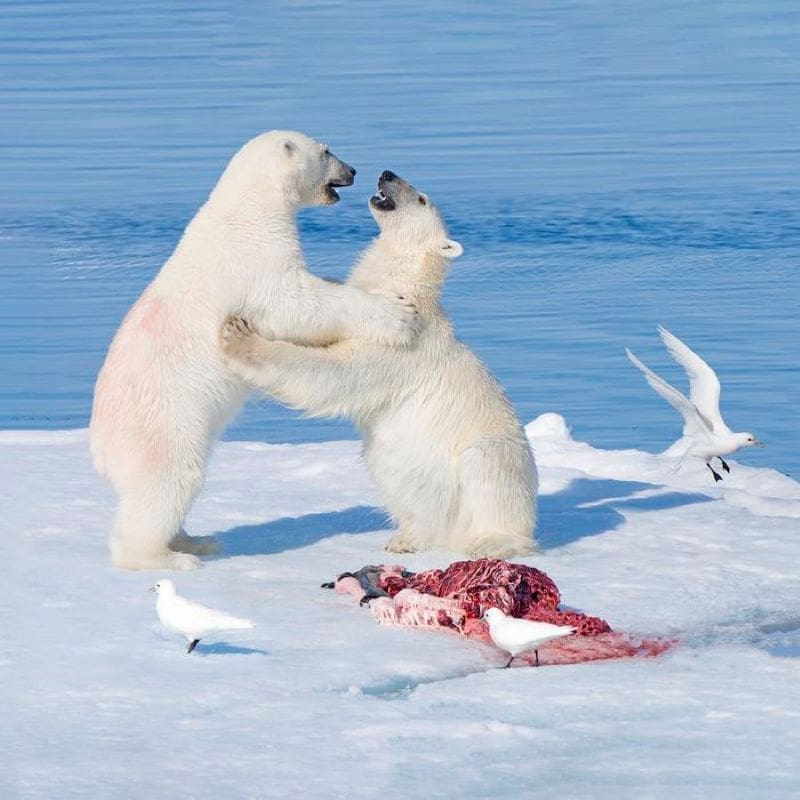
Past research has emphasized that continued warming in the Arctic and the resulting loss of sea ice directly endanger polar bear populations. However, this new research highlights that a decline in polar bears would not only impact the species itself but the loss of the carrion they provide could have significant consequences for the entire Arctic ecosystem.
“Our research highlights the important role of polar bears as carrion providers,” says Dr. Nicholas Pilfold, Scientist in Population Sustainability at San Diego Zoo Wildlife Alliance. “The sea ice acts as a platform for many species to access scavenging resources provided by polar bears, and ultimately, declines in sea ice will reduce access to this energy source. Our findings indicate that documented declines in polar bear abundance in two subpopulations have already resulted in the loss of more than 300 tonnes of food resources for scavengers annually.”
These findings highlight the interdependence of Arctic wildlife species and their shared vulnerabilities in the face of rapid environmental change. With polar bear populations continuing to decline, this research underscores the urgency of conservation efforts to protect them, not only for their own sake but for the species that rely on them.
Journal Reference:
Gamblin, H.E.L., Derocher, A.E., Richardson, E.S., McGeachy, D., Roth, J.D. and Pilfold, N.W., ‘Predators and scavengers: Polar bears as marine carrion providers’, Oikos e11628 (2025). DOI: 10.1002/oik.11628
Article Source:
Press Release/Material by Claire Sweeney | San Diego Zoo Wildlife Alliance
California schools are losing tree canopy
About 85% of elementary schools studied in California experienced some loss of trees between 2018 and 2022, according to a paper from the University of California, Davis, published this month in the journal Urban Forestry and Urban Greening.
Members of the UC Davis Urban Science Lab found that while the average decline was less than 2%, some districts in the Central Valley – including schools with few trees to lose – lost up to a quarter of their tree cover. The most severe losses were concentrated in Tulare County, while the most notable gains were found in Imperial County.
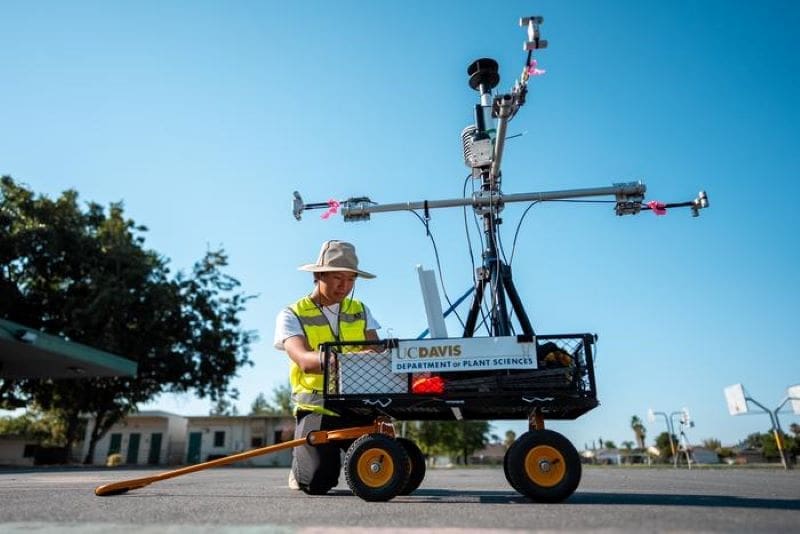
The findings are troubling as climate change will likely intensify extreme heat and drought conditions. The study underscores an urgent need to improve tree canopy in low-shade, high-need schools and to protect existing tree cover in areas facing loss.
“We are trying to measure to what extent we are exposing kids to temperatures that might be stressing their body to a level that becomes uncomfortable or dangerous,” said Alessandro Ossola, an associate professor of plant sciences who directs the Urban Science Lab at UC Davis.
The team continued the research this past summer at elementary schools across the state, measuring tree canopies and maximum temperatures at playgrounds, basketball courts, soccer fields and other outdoor spaces.
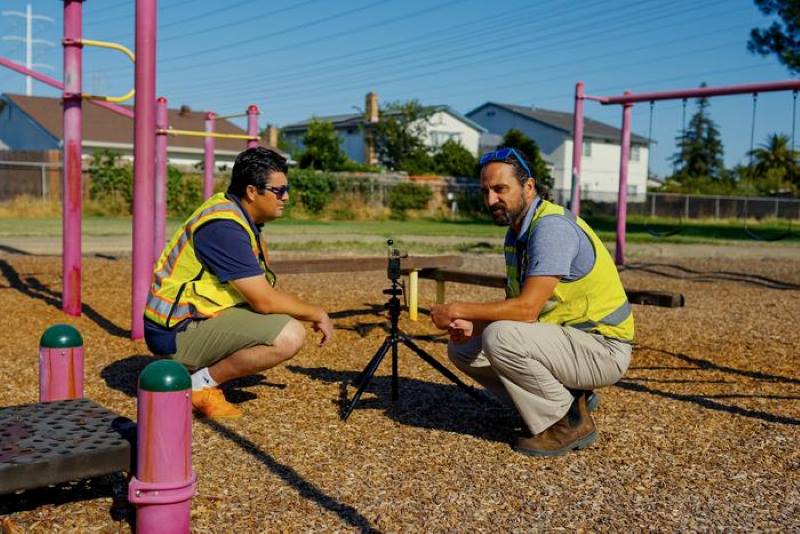
Tree canopies cover only about 4% to 6% of the average California school campus. That means the roughly 5.8 million K-12 public school students in California often take breaks and participate in outdoor activities under the glaring sun.
As part of the work, researchers mapped tree cover and heat over the course of a hot day at schools in inland and coastal areas of Northern and Southern California.
The research is a joint effort with UC Davis, UC Berkeley and UCLA and is funded by the U.S. Forest Service and supported by the nonprofit Green Schoolyards America through its California Schoolyard Tree Canopy study.
“Most schools are actually a nature desert, which is antithetical because we know that early life exposure of humans to nature is critical for them to develop skills, improve their microbiome, become more environmentally active and so on,” Ossola said. “Trees are a hidden asset and an underutilized asset.”
Journal Reference:
Luisa Velasquez-Camacho, Moreen Willaredt, Pooja Singh, Alessandro Ossola, ‘Bleeding green: California’s schools are rapidly losing tree canopy cover’, Urban Forestry & Urban Greening 113, 129117 (2025). DOI: 10.1016/j.ufug.2025.129117
Article Source:
Press Release/Material by Emily C. Dooley | University of California – Davis (UC Davis)
As global warming worsens, so may space communications
Researchers at Kyushu University have found that rising CO₂ levels in our atmosphere could lead to future disruptions in shortwave radio communications, including systems used for air traffic control, maritime communication, and radio broadcasting.
While we know that increasing CO₂ levels in our atmosphere causes global warming at Earth’s surface, something different is happening in the ionosphere located 100 km above sea level. Up there, it’s cooling.
“This cooling doesn’t mean it is all good. It decreases the air density in the ionosphere and accelerates wind circulation,” explains Professor Huixin Liu of Kyushu University’s Faculty of Science, who led the study published in Geophysical Research Letters. “These changes affect the orbits and lifespan of satellites and space debris and also disrupt radio communications through localized small-scale plasma irregularities.”
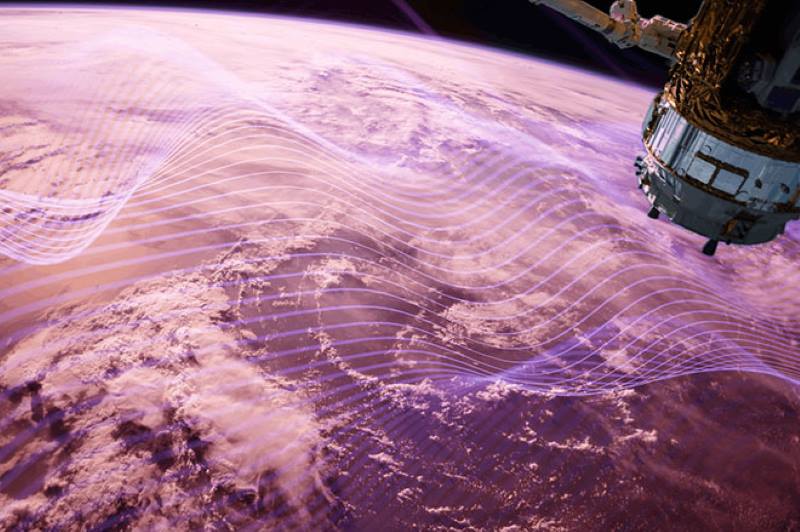
One such irregularity is known as ‘sporadic-E’ or ‘Es,’ a phenomenon where a dense layer of metal ions forms at an altitude of 90 to 120 km.
“As the name suggests, Es are sporadic and difficult to predict. However, when they occur, they can disrupt HF and VHF radio communications,” continues Liu. “Our results revealed that, at high CO₂ levels, Es tend to become stronger, occur at lower altitudes, and persist longer at night.”
Using a whole-atmosphere model, Liu and her team developed simulations of the upper atmosphere under two different CO₂ concentrations: at normal concentrations of 315 ppm, and then at 667 ppm (the average atmospheric CO₂ level in 2024 was 422.8 ppm). They then evaluated changes in vertical ion convergence (VIC), which drives Es.
Their simulations revealed that, at higher atmospheric CO₂ levels, VIC is enhanced globally at altitudes of 100-120 km; the Es hotspots shift downward by approximately 5 km; and their diurnal patterns change. Further investigation revealed that these changes were caused by lower atmospheric density and wind disturbances.
“These findings are the first of its kind to show how increasing CO₂ affects the occurrence of Es, revealing new insight into cross-scale coupling processes between neutral air and ionosphere plasma. In other words, they show how global climate-driven changes can impact small-scale plasma phenomena in space,” explains Liu. “Considering our findings, the telecommunications industry will need to develop a long-term vision that accounts for the impacts of global warming and climate change in their future operations. Global warming affects not just the Earth but extends well into space.”
Journal Reference:
Rifqi, F. N., Liu, H., Qiu, L., Tao, C., & Shinagawa, H., ‘How does increasing CO₂ concentration affect the ionospheric sporadic-E formation?’, Geophysical Research Letters 52, e2025GL117911 (2025). DOI: 10.1029/2025GL117911
Article Source:
Press Release/Material by Kyushu University
Featured image credit: Gerd Altmann | Pixabay




